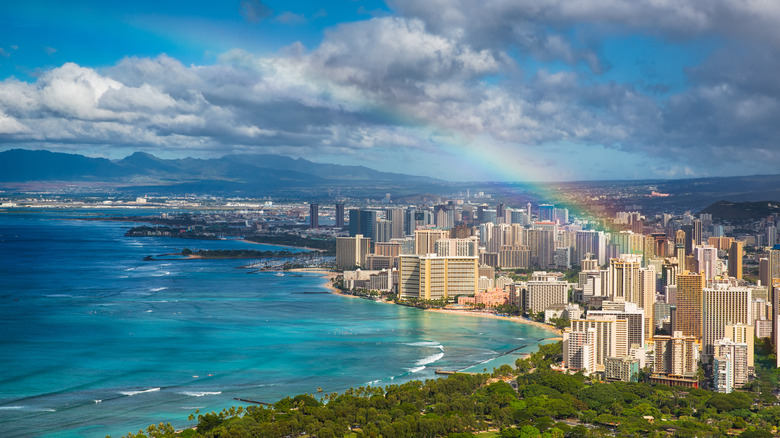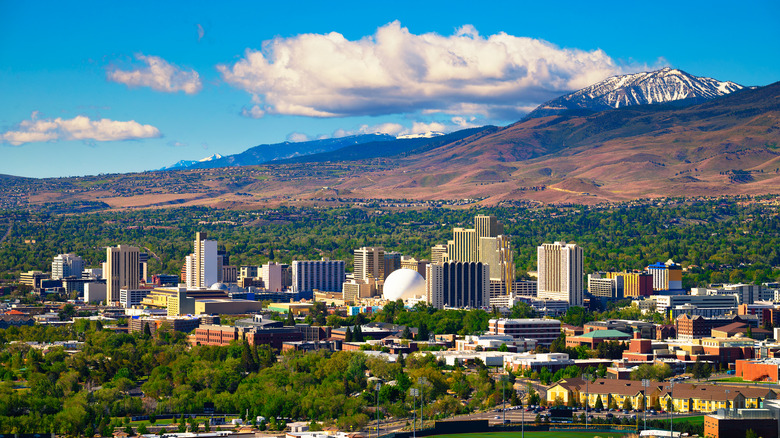America's Best-Smelling Cities, Per The Internet
The sense of smell is one of the most captivating yet peculiar human senses. It's closely tied to the brain's ability to conjure memories and evoke powerful emotions. It aids survival by helping us avoid danger, identify and taste nutrient-rich foods, and even select a mate. Remarkably, it's also the earliest sense developed in the womb. Pleasant smells can transport us; unpleasant ones can warn us. And odors can undoubtedly influence how you feel about a trip to a different city, which is why we set out to explore which American cities smell the best — with the help of previously published rankings and online comments. Based on internet evidence, six cities emerged as standouts: Seattle, Honolulu, Santa Fe, Santa Cruz, and Reno.
While scent is subjective, certain universal qualities emerged: flora like rosemary, lavender, and pine; coastal breezes; limited industrial or sewage odors; and distinctive cultural aromas — in the way, for example, Grenada smells like cookies. We focused on cities that smell appealing year-round and have a reputation for signature scents. Some cities enjoy brief fragrant seasons but are also known for unpleasant odors, so they didn't make the cut. Take Los Angeles, often cited as one of the most polluted and worst-smelling U.S. cities, yet in spring, its jasmine blooms can briefly mask the urban funk.
Marcel Proust, the turn-of-the-century French writer, famously explored how sudden sensory triggers, including smells, can unleash vivid moods and memories. Think about the last time you inhaled warm pine needles or caught the briny breeze in a coastal town. What rose to the surface? Whether you're aiming to share a mood or rekindle a moment, let this list of America's best-smelling cities guide your next aromatic escape.
Seattle smells like rain and petrichor
Many rainy parts of the country — especially the Pacific Northwest — are often praised for how good they smell, thanks in large part to petrichor. Petrichor is the earthy scent released when rain hits dry soil. When raindrops strike the ground, they help release geosmin, a naturally occurring compound produced by soil microbes, creating that unmistakable aroma of damp earth and post-rain leaves. It's a smell so primal that fragrance scientists have spent years trying to replicate it.
Though the entire Pacific Northwest claims a stake in petrichor, Seattle, Washington, arguably reigns as the best-smelling city in the region. Ranked No. 2 (after Portland) on OxiFresh's 2025 list of America's cleanest cities, Seattle also gets rave reviews from locals and visitors for its fresh-air appeal. "[I] was struck by how crisp and clean the air smelt when I got out of the airport," wrote one Reddit user. "Fresh tree and rain smell ... Unbeatable," added another in the same thread. "You could drop anyone from Seattle blindfolded in Seattle without telling them that they are in Seattle and they would know," declared another. "It's the salt/pine combo."
"The Emerald City," as Seattle's nicknamed, is an urban center nestled inside a massive green space, averaging nearly 40 inches of rainfall per year and surrounded by 4 million trees (roughly 30% of the city's land area) with easy access to nature, from kayaking Puget Sound to hiking around the foothills of Mount Rainier. Set along the Pacific coast, it also benefits from salty sea air. "I grew up in Seattle but have lived elsewhere for a good chunk of my adult life," wrote one Redditor. "I go back to visit a few times a year and the smell/feel of the air is so distinct."
Honolulu smells like trade winds, tropical flowers, and ... happiness?
The capital of America's 50th state has also earned recognition as one of the cleanest cities in the world, according to a 2023 Mercer Eco-City study that cited Honolulu's shift toward electric transit, limited industrial presence, and a strong climate action plan. It also ranked No. 2 on Prilla's 2025 list of the best-smelling cities. But Honolulu is a major tourist hub and developed urban center — so what does it actually smell like?
"That's a really funny question because I've had to explain it to a few people including my children," wrote one user on Quora. "It smells like a bouquet [of] flowers." Some visitors mention the diesel fumes near the airport, but most agree the scent fades once you're in the city proper. Others describe plumeria, the creamy tropical bloom often woven into leis. Although not native to Hawaii, plumeria does smell lovely up close — though not every variety carries the same strong fragrance. Another commenter on Quora claims the island's trade winds — part of Honolulu's salty-clean smell — disperse tropical floral scents into a barely-there essence.
Hawaii resident and candlemaker Alina Quinata has tried to capture Hawaii's fragrances, which she told KHON2 are white Hawaiian ginger, fruit, and pikake – the ancient royal lei bloom — in her handmade candles. The scents of the islands contain Proustian emotional feelings for Quinata. "For each of us, the scents of Hawaii will smell differently and have different meanings," she says, "but in most cases, they smell like happiness."
Santa Fe smells like piñon and roasting chile peppers
"Go to NM when they are roasting chiles on the corners," urged a user on Reddit. "Smell the Piñon. Go in the store, buy a tortilla and slices of cheese. Roll up the chiles & cheese in the tortilla. Watch the sun go down over the mountain." Santa Fe is New Mexico's historic state capital and an artsy paradise, but it's also the scent capital of piñon, sage, juniper, and chile peppers. There's petrichor, too, though it's different from the Pacific Northwest's; New Mexico Magazine described the smell as emanating from Adobe dust of straw and sediment, alongside a nickel-esque petrichor that rolls in from the distant mountains. Hollyhocks, flowering herbs, fruit trees, and pine sap warmed by the sun also drift throughout the city.
Yet the piñon stands out, a sweet, buttery, pine-y nut that's been a mainstay of local Native diets for generations. The official state tree of New Mexico, the piñon, thrives in arid, desert climates. Residents scour the desert hills for them, and vendors crack and roast them. "I love the smell of Piñon wood burning coming from the kivas/fireplaces while in Santa Fe," wrote one Redditor. Piñon sap is also used as a balm and burned as incense. Sadly, climate change effects — like prolonged drought and invasive beetle species — are negatively impacting the piñons, as the National Park Service has noted; conservation is essential.
Santa Fe's also known for its chiles, harvested, roasted, and charred over open flames — often in shopping center parking lots — dispersing the smoky-sweet scent throughout the city and ushering in autumn, New Mexico style. According to the U.S. Department of Agriculture, New Mexico chile production totaled 52,000 tons in 2024.
Santa Cruz smells like redwoods, eucalyptus, and Pacific surf
On California's north-central coast, Santa Cruz nestles in toward a landscape of mossy, coast redwood forest, where the air carries the earthy musk of petrichor, not unlike Seattle. Santa Cruz does boast a comparable amount of annual rainfall to Seattle, but its rich redwood forests release their own distinctive perfume: bark, soil, and the warm resin of terpenes, a natural protective oil produced by the trees (which are native and exclusive to California and southern Oregon). Threaded throughout the region are blue gum eucalyptus trees, which waft a sharp, camphor-menthol. Though considered controversial because they're an invasive hardwood prone to becoming tinder-dry — and therefore a wildfire risk — their minty scent is unmistakable, and their branches shelter cacophonies of birds. If you purchase a "Santa Cruz"-scented candle (yes, they exist!), you're likely to detect waxy notes of mossy redwoods, eucalyptus, and salty sea.
Though legally a city, Santa Cruz feels like a coastal college town, with a population of about 62,000 that swells when the University of California at Santa Cruz is in session. It's a playground for outdoor enthusiasts, who can hike or cycle among redwoods or along scenic ocean-view ridges, roam local arboretum gardens, ride horseback through wine country, stroll the beaches, or wade in tide pools. It's also where surfing first came to America, introduced to the mainland by Hawaiian royalty who discovered its world-renowned breaks that have since attracted surfers from all over. Along the shore, the breeze carries the pungent smell of kelp and sea. "Santa Cruz has a distinct aura," wrote u/CommanderALT on Reddit. "It not only looks beautiful, but even smells nice as well." Another Redditor, u/Butyistherumgone, agreed: "When I moved to Chicago and then came back...I couldn't get over how amazing it smelled."
Reno has a warm and mostly neutral scent
The marketing analysis by Prilla, which named Honolulu the second-best-smelling city in America, also ranked Reno as the top-smelling city in the U.S. The report suggested that "desert climates and lower humidity help keep bad smells from lingering" — one reason mountain and coastal cities in the West dominated the "fresh air" rankings.
On Reddit, one traveler asked the community why they notice "a pleasant, sweet" smell every time they arrive in Reno, regardless of the season. "I can also detect it when going in the mountains. It's more pronounced when it's dry, which is odd, since usually humidity brings out all kinds of smells," the poster wrote, guessing it might come from a tree. Many users chimed in, saying the scent is likely sage, which is widespread in the region. Others pointed to Jeffrey pines — common in the Sierra — which are known for their warm, vanilla- or butterscotch-tinged aroma.
Not all Reno scents are idyllic, though. You may also get a whiff of the notoriously foul-smelling Bradford pear trees that bloom in spring, releasing putrescine, a compound that smells like decaying fish or garbage. Add occasional pockets of sewage, typical urban odors, and Nevada's rampant wildfire smoke that increasingly affects much of the American West, and the air isn't always perfect. Still, compared with the muggy swamps of the East Coast, Reno remains a pleasant, walkable "big little city" that manages to hold on to its reputation for clean, crisp, good-smelling air.
Methodology
To determine the best-smelling cities in America, we first defined what counts as a "city." Many small towns and nature-rich regions claim to have the freshest air — and some certainly do — but the U.S. Census Bureau classifies a "city" as an "incorporated place," with the specific criteria further determined by each state, and it defines "urban areas" as population centers with at least 5,000 residents. Every city on our list meets those qualifications, except Honolulu, which is not technically incorporated by the U.S. Census Bureau but is treated as a census-designated place. Still, with an estimated population of more than 344,000 in 2024, Honolulu clearly fits the scale and character of an urban city for this list.
To identify the best-smelling cities, we drew on a mix of sources: official or data-driven rankings, like OxiFresh's 2025 list of the cleanest cities in the U.S., Prilla's marketing analysis on America's best-smelling cities, and public sentiment — including wide-ranging Reddit discussions. We also added a dash of our own editorial experience — after all, scent is personal, and lived impressions matter.
We also focused on cities whose defining smells are more universally beloved. Scents with broader appeal include floral, woodsy, spicy, and coastal breezy. For balance, we included Reno, whose subtle, clean, and award-recognized neutrality earned a spot — because sometimes, no smell is better than a bad one. Our hope is that reading this list evokes a few memories of your own — or inspires your next trip somewhere you can reconnect with your sense of smell, the most elusive and wondrous sense of all.






